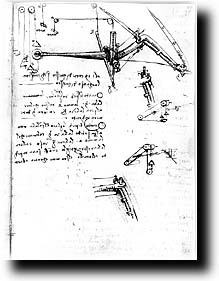by
Silvia Messeri
"The great bird will take flight ...filling the
universe with wonder..."
"The Codex on the flight of the birds", the famous manuscript containing
the notes, sketches and drawings that Leonardo prepared in 1506 in Florence,
has at last come back to its city of origin to enrich the splendid exhibition
on "The Renaissance engineers. From Brunelleschi to Leonardo da Vinci".

Flying machine by Leonardo |
This small 18 page notebook, which was numbered by Leonardo himself,
has remained miraculously intact, in spite of its somewhat eventful history,
since the death of its author. Apart from its main theme on flight, it
also contains mechanical research, an anatomical drawing, botanical sketches,
a rough portrait of an old man, which is very similar to his well known
self-portrait, and notes on his expenses, including the purchase of a
chicken for the price of two five-centesimi coins.

Detail of flying machine by Leonardo |
However most of the notes and drawings are studies on flight in its
various aspects; thus we can find research into the winds and currents
and the way they are exploited by birds, wonderful sketches on the physical
structure of certain breeds of bird, and the various positions, according
to the direction of the wind, that are assumed by their tails in flight.

A page from the "Codex on the flight
of birds" by Leonardo
on loan from the Royal Library in Turin in the exhibition in Florence
|
This precious Codex is exhibited on loan from the Royal Library in
Turin, which has also lent the beautiful drawing, again by Leonardo, of
the battle chariots armed with scythes.

In 1977 Californian Bryan Allen crossed
the English Channel in a"flying machine".
It was the first flight using
the strength of man alone. |
The latter is part of a series of studies on military devices that
Leonardo carried out between 1482 and 1485, when he was in Milan at the
service of Ludovico il Moro. Drawn by galloping horses, two chariots,
armed with enormous razor-edged scythes, litter the ground with mutilated
bodies. The terrible beauty of the drawing reminds us of Leonardo's mortar
drawings. These were not only provided with a mechanism to regulate their
range, they were also supplied with cannon balls that, when they were
fired, would burst open and scatter smaller shells. Bombs based on the
same principle were used during the war in Vietnam by the American air
force. The exhibition on "The Renaissance engineers. From Brunelleschi
to Leonardo da Vinci" (Florence, Palazzo Strozzi until January 6th
1997) can also be found in Internet: http://www.imss.fi.it/news/mostra/indice.html
See also: Incredible machines, from
Brunelleschi to Leonardo, human invention during the Renaissance in an
exhibition in Florence

FAN-Florence
ART News
by
Silvia Messeri & Sandro Pintus
|






